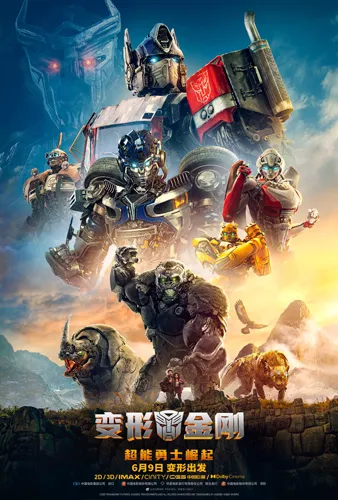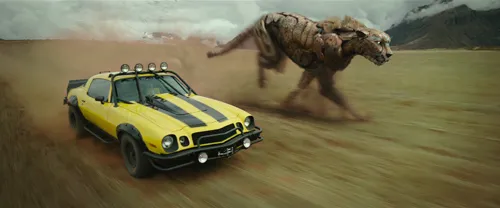Transformers: Rise of the Beasts - A Case Study in Hollywood’s Creative Stagnation
By Liu Jian, Associate Professor at Tianjin Art Vocational College and Special Expert at the China Science Fiction Research Center
The latest installment in the Transformers saga, Transformers: Rise of the Beasts, premiered simultaneously in North America and China on June 9, 2023. As the seventh film in the series, its performance can only be described as adequate. After the “epic” failure of Transformers: The Last Knight in 2017 and the relative success of the spin-off Bumblebee in 2018, Transformers: Rise of the Beasts couldn’t afford to disappoint. The underlying reason for this precarious situation lies in the increasingly rigid and conservative creative approach of Hollywood science fiction films.

Transformers: Rise of the Beasts Poster
The Enduring Legacy of Transformers
For those born in the 1980s, both in the East and West, “Transformers” is more than just a well-known science fiction IP; it’s a fundamental part of their childhood memories. In 1983, Hasbro, a prominent American toy distributor, introduced plastic transforming robot toys developed by Japan’s Takara to the United States. To promote toy sales, Hasbro partnered with Marvel Comics to launch the Transformers comic book series. Subsequently, they collaborated with Sunbow Productions and Marvel Productions to produce a three-part animated series, The Transformers: More Than Meets the Eye. Due to positive reception, this animated work, initially intended as a toy advertisement, was expanded into a television animated series, eventually becoming the widely recognized Transformers G1 series. In 1988, the Transformers G1 series was introduced to China, airing on several local television stations. This led to a surge in sales of Transformers plastic model toys in China. It was the first time the Chinese people truly experienced the commercial impact of animation derivatives after the reform and opening up, providing a commercial model for the future development of the domestic animation industry.
From Animation to Live-Action: A Promising Start
In the early 21st century, with the revolutionary advancements in computer graphics technology, computer effects were applied to live-action films, creating incredibly realistic characters and scenes. This made it possible for Transformers to step out of the two-dimensional world of animation and into the three-dimensional world of humans. In 2007, Hasbro partnered with Paramount to release the first live-action film in the Transformers series, Transformers. As the series’ inaugural work, Transformers cleverly intertwined seemingly unrelated elements such as current events, family matters, and popular culture through the machine aliens from Cybertron searching for the “AllSpark” on Earth. This allowed audiences to genuinely feel that Transformers might actually appear outside their windows. This “realism” allowed both die-hard fans of the Transformers animation and casual viewers seeking entertainment to immerse themselves and find satisfaction in the viewing experience. Transformers: Revenge of the Fallen, released two years later, largely followed the creative approach of the first film, achieving both critical and commercial success.
The Downward Spiral: A Loss of Identity
However, starting with Transformers: Dark of the Moon in 2011, the Transformers series embarked on a path of “letting itself go.” Compared to the first two films, Transformers: Dark of the Moon’s plot felt overly simplistic, and both the “old characters” inherited from the first two films and the hastily introduced “new characters” appeared very stereotypical, losing the relatively full character arcs of the previous two films. The Transformers, the main selling point, invariably became mere tools. With Transformers: Age of Extinction, the series underwent a “soft reboot,” with the entire human protagonist group from the first three films being “laid off” and replaced by new characters, restarting the storyline. Although this film introduced popular characters from the original Transformers animation, such as the “Dinobots,” the numerous inexplicable product placements and various unrewarding scene settings still drew criticism. Ultimately, it earned box office success but lost critical acclaim.
The “Epic” Failure and a Glimmer of Hope
Transformers: The Last Knight, released in 2017, suffered an “epic” collapse. It’s worth noting that around the time of Transformers: The Last Knight’s release, Disney’s “Marvel Cinematic Universe (MCU)” had taken shape and was playing the role of a box office harvester in the global commercial film market. Paramount apparently wanted to follow suit and establish a “Transformers Cinematic Universe.” Thus, Transformers: The Last Knight, building on the storyline of Transformers: Age of Extinction, expanded the world-building of the Transformers series, even incorporating the famous Western historical legend of “King Arthur and the Knights of the Round Table,” giving it the feel of Sun Wukong fighting Ultraman. Even more ridiculously, the screenwriter even “borrowed” heavily from the story segments in American novelist Dan Brown’s bestselling novel The Da Vinci Code, turning Transformers: The Last Knight into a complete “Freemason” conspiracy theory story. With such operations, box office failure was only to be expected. As a result, Paramount had to cancel subsequent plans, retaining only a spin-off film called Bumblebee. This film completely abandoned the world-building settings of the first five works, pulling the timeline back to the 1980s, and shifting the focus of the entire film to the emotional interaction between the Transformers and the human protagonist. Although no scenes left a deep impression on fans, the film managed to salvage some reputation for the Transformers series through emotional portrayal.
Rise of the Beasts: A Missed Opportunity?
Transformers: Rise of the Beasts is based on the Beast Wars: Transformers television animated series produced by Hasbro in 1996, hailed as the “authentic sequel to the American version of Transformers G1.” This was also the first animated work in the Transformers series to use full 3D animation technology. Due to the limitations of the technology at the time, the animation quality was quite dated, but thanks to the excellent script, it became a “revival work” of the Transformers animation series, and also cultivated many new generation fans for the Transformers series worldwide. Obviously, the producers hoped to introduce new characters from “Beast Wars” so that the Transformers series of films could sell another wave of nostalgia, so that the “post-90s” audiences who were obsessed with “Beast Wars” back then, who have now grown up, would also pay for the new film.
However, this goal is likely to be difficult to achieve. First of all, the basic settings of the film are too complex. The Transformers series has always used a simple binary worldview of good versus evil as the basis for constructing the story, but in Transformers 7, there are four factions of Transformers alone: “Autobots,” “Maximals,” “Terrorcons,” and “Unicron.” Such a complex faction division is obviously not very friendly to ordinary audiences. Moreover, when you see some Transformers turning into cars and others turning into beasts, and the two factions running together in the wilderness, it always gives people an unspeakable sense of incongruity.

Transformers: Rise of the Beasts Still
Secondly, the role of human characters in the film is significantly weakened, and their motivations are difficult to grasp. Fundamentally, the protagonists of Transformers movies must be transforming robots, but human characters should also play a key role in driving the plot and eliciting empathy from the audience. However, the male and female protagonists in this film are difficult to give people a refreshing feeling from the perspective of casting, and because of the lack of corresponding plot foreshadowing, the characters’ motivations also lack persuasiveness, giving people a feeling of being manipulated by the director.
Thirdly, the plot lacks ups and downs and has a sense of being a. As a result, even at the final decisive moment, it still fails to bring enough tension to the audience, making the final reversal of the righteous side seem very deliberate and lacking a hearty sense of.
The Rise of Chinese Sci-Fi and the Future of the Genre
It is not difficult to see that Paramount wants to turn the Transformers IP into a goose that can continuously lay golden eggs, but on the other hand, it is afraid of taking too much risk and encountering risks, so it plays it safe everywhere, playing the nostalgia card, not seeking merit but seeking no fault. Paramount is not the only one with similar ideas. This is the general mentality and practice of large Hollywood production companies when producing science fiction themes in recent years. If it were before 2019, global movie audiences would probably only accept it silently, because the basic model of contemporary commercial science fiction blockbusters is defined by Hollywood. However, with the emergence of Chinese science fiction blockbusters represented by the The Wandering Earth series, it has brought a new definition to science fiction films that is different from the Hollywood model. This is like when there was only the “International Space Station” in near-Earth orbit, people naturally felt that it was natural for the various equipment on the space station to use English labels, but when the Chinese sent the “Tiangong Space Station” into space, people realized that it was also normal and reasonable to label the space station equipment in Chinese. Therefore, by comparing the Transformers series with the The Wandering Earth series, we can clearly see that only by continuously promoting the continuous development of Chinese science fiction films can the Chinese people truly grasp the right to define science fiction films, and can truly effectively resist cultural hegemony, so that Chinese-style modern technology and culture that reflects the development achievements of contemporary China can be more internationally communicable and influential.